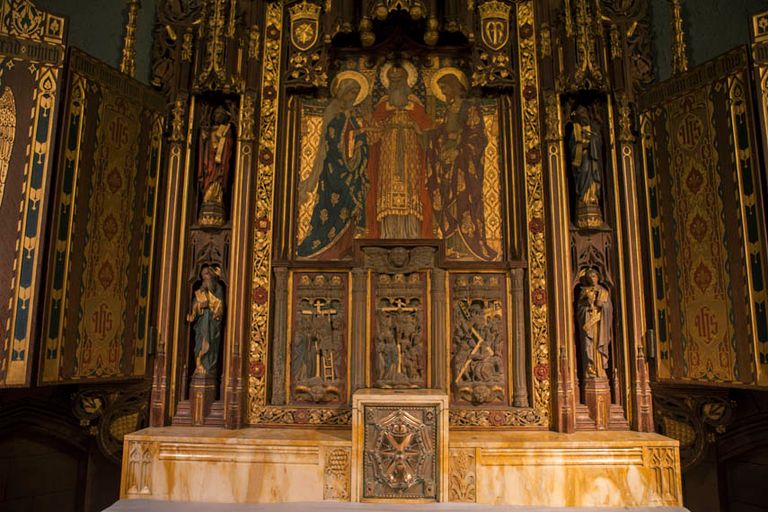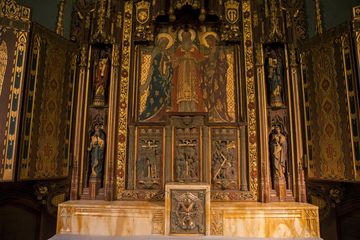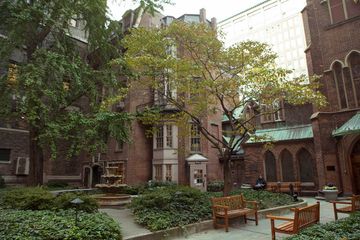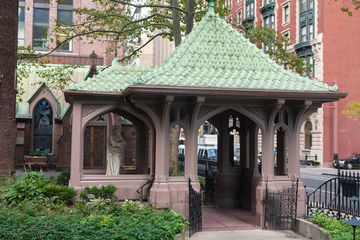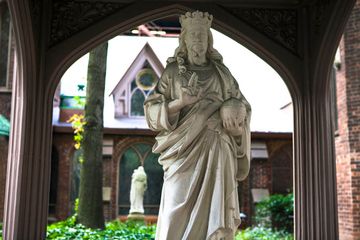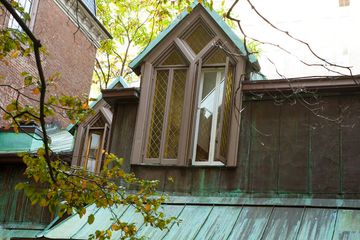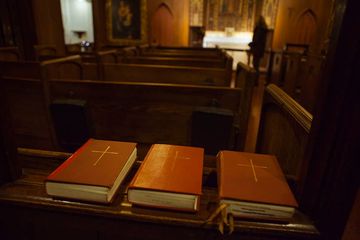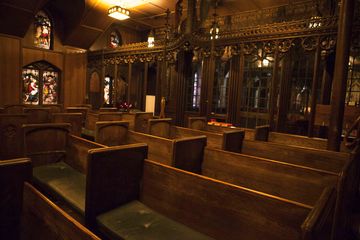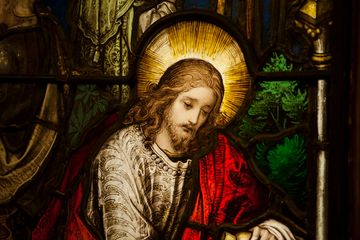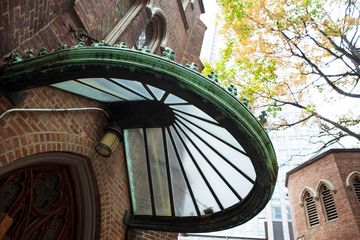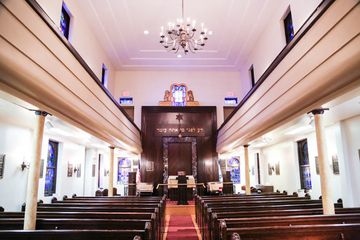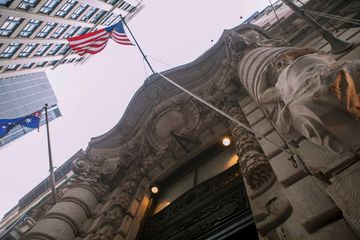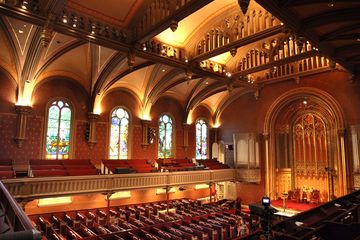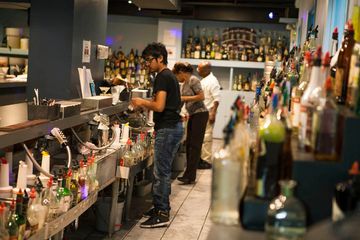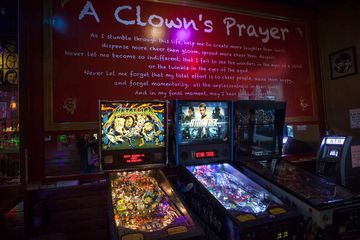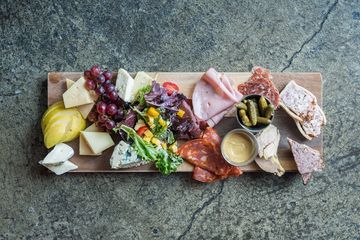Completed in 1854, and housing a congregation that dates back to the 1600s, Marble Collegiate Church is one of the most prominent and stunning churches in New York. Its exterior stands out among the glimmering towers of Fifth Avenue – a breathtaking reminder of a smaller-scale New York of the nineteenth century. Several of us had the privilege of receiving a tour of Marble's magnificent space. Ashley Johnson, Marketing and Communications Manager, and our tour guide for the day, impressed us with her vast knowledge of the historic landmark. Pausing first at the exterior, Ashley explained the imposing iron fence surrounding the building – “It was originally to keep out cows, ” she laughed. “Our nearest neighbor was a dairy farmer. Back in the 1800s, this was considered the sticks! You would’ve taken a carriage up Fifth Avenue (then a dirt path) to get here. ” The blue and yellow ribbons hanging on the fence, she went on to say, are tributes to the soldiers and civilians injured or killed in conflicts in Iraq and Afghanistan. Moving to the interior, we were struck by the lavishness of the sanctuary. One Manhattan Sideways team member exclaimed: “I’ve never seen a church with wallpaper before! ” Ashley clarified, “It’s actually not wallpaper – it’s stencil. ” The walls are painted a lush red, decorated with gold stencils of the fleur-de-lis. Complementing the deep color of the walls is the matching red upholstery covering the pews. After we had stared in awe for a considerable period of time, Ashley said: “The way you see this space now is how you would have seen it in 1891. This is High Victorian – not how it was originally conceived. ” The church’s sanctuary, then, is a living record of the aesthetic changes to Marble Church. “When it was originally built, it was very stark – true to its Calvinistic roots. ” There was clear glass in the windows at that time, she told us, and the interior was white and dominated by a central pulpit on the chancel. These features were later upgraded when Dr. David James Burrell became the senior minister of the church in the late 1800s. He removed the pulpit, “wanting to be closer to his congregation, ” and oversaw extensive renovations of the sanctuary, including replacing the clear glass windows with stained glass, which can still be seen in the front hall narthex of the church. In 1900 and 1901, the church began what was to become a century-long project of replacing all the plain stained glass windows with the multi-colored pictorial scenes you can view today. The first two pictorial stained glass windows, installed at the turn of the nineteenth century, were fabricated by the world-renowned Tiffany Studios, headed by Louis Comfort Tiffany. Depicting Biblical stories, the church’s oldest windows are breathtakingly detailed, featuring hand-painted, colorful glass of diverse textures and thicknesses. It is certainly easy to get lost in their storytelling. After the windows were installed, there was a long hiatus before the next window was commissioned. Ashley suggested a number of reasons for the wait: the Great Depression, WWII, and stained glass falling out of vogue. “The church had all of these Victorian style stained glass windows without pictures, and then there were these two Tiffany windows sitting right in the middle; it was a beautiful oddity. ” In 1998, thanks to the generosity of church patrons Robert and Maria Ryneveld, Marble Collegiate Church set out to complete the vision that had begun 98 years earlier. As other patrons stepped forward, Marble began commissioning new windows, designed by talented artisans and created by some of the oldest, great stained glass fabricators in America: Rambusch, Lamb and Willet-Hauser. Today, the sanctuary window project is complete and houses 10 stunning stained glass windows, one after another. Standing close to many of them, we were able to observe each composition in dizzying detail. Continuing on our walk through the church, Ashley showed us the smaller, though no less beautiful, spaces Marble Church houses. Behind the sanctuary the children’s chapel is nestled. Decorated with beautiful frescos of scenery, it is a place for children and adults to find quiet. “It would be great for people to know about these spaces, ” Ashley pointed out, adding that the children’s chapel is also ideal for intimate weddings and other ceremonies. Moving on, we visited a smaller prayer chapel, as well as a parlor decorated with photos of Marble Collegiate Church at its various states of construction and renovation. Then we were led downstairs, to a large labyrinth in the basement. “This is one of the only inlaid labyrinths in the city, ” Ashley informed us. “It’s open to the public on Wednesday evenings and the first Sunday of the month. It’s a very relaxing place, ” she said. “Many people confuse this with a maze, but it's not – it’s a labyrinth, so there’s no way to get lost. ” As we were contemplating the winding pathways, the staff at Marble was preparing for one of their frequent walking events, lining the labyrinth with tea lights. We all agreed that it is rare for one to be able to have this kind of meditative experience in Manhattan. After visiting the basement chapel – a small, contemporary room outfitted with hardwood – we moved into the peaceful columbarium. “It’s very unusual to find places to put loved ones to rest in New York, ” Ashley mentioned. A somber note to end on, but we certainly appreciated the time spent inside Marble Collegiate Church.
